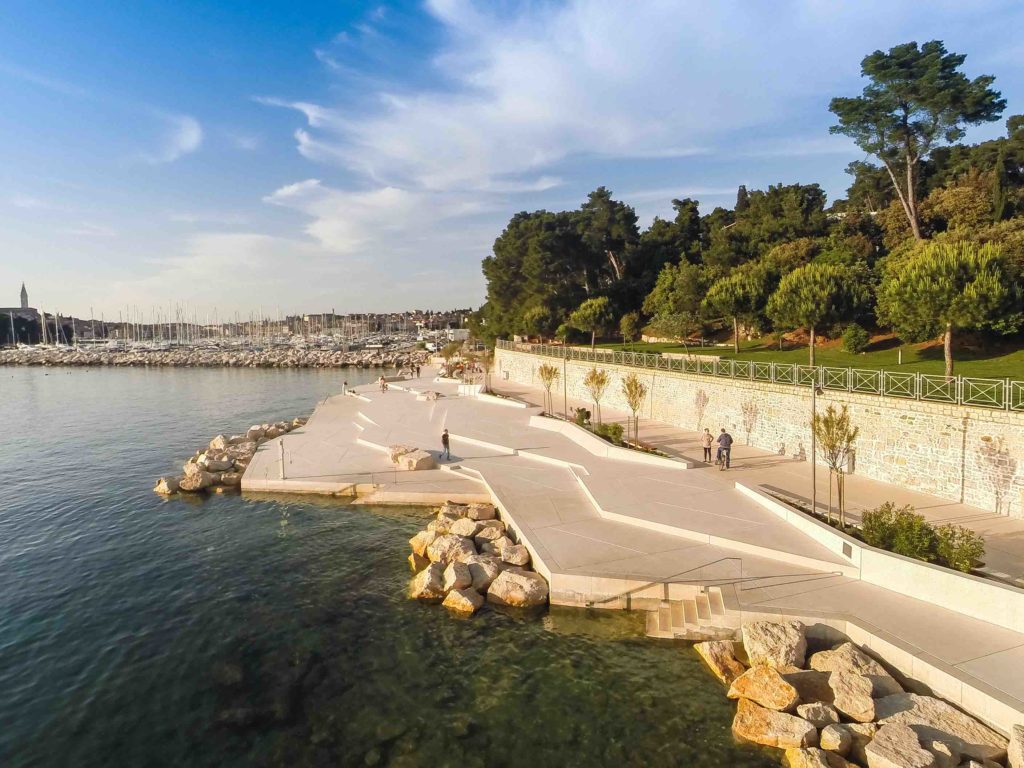
Architect
Studio 3LHD
Type of Area
Sea
Land/water interaction
Stony beach
Promenade
Terraces/steps
Built Environment Types
Low built
High green
Scale of Impact
City
Regional
Intervention Scale (Spatial)
Large site
Project Types
Seafront development
Urban design
Outdoor recreation
Urban/ Rural
Urban fringe
Visibility and Openness
Partly enclosed
Partly contained view
A New Cultural Centre
Croatia has an extensive, steep, rocky coastline where locals have traditionally cut steps and railings into the rocks to access the water for swimming. Located in the city of Rovinj and next to the protected Punta Corrente forested park, the Mulini Beach extends the beach area, giving greater access to the water, close to the seaside hotels, as well as providing additional public space. The promenade, connects the beach to the city centre and provides a pedestrian and cycle route.
The beach was designed to reflect the local rocky terrain and changes according to the tides, that vary by up to 80cm in height. Recreational beach facilities include a bar with locker rooms, showers and toilets, thus providing many of the facilities required for an enjoyable day by the crystal-clear waters of the Adriatic Sea. Deck chairs and umbrellas are also available for hire from the local hotels. A plateaued area in front of the bar provides space for small outdoor events such as concerts. The adaptable design of the bar area provides shade from the sun during the day via a 6-sided pergola roof, designed according to the movement of the sun during the summer months. It can also be turned into a bar with a cosy intimate atmosphere at night using sliding walls.
The beach area consists of a series of terraces constructed from sandstone and white concrete and divided into two zones, with a bay area and a pebble beached area. Although the area is terraced, ramps allow wheelchair access down to the water’s edge. Fragmented surfaces with little vegetation provide space for sunbathing, but this is often packed with people in this popular spot. The pebble beach slopes gently down to the sea providing easier access for children to the water.
Perception and Meaning
Imageability
Legibility
Sense of place
Accessibility
Place identity
Health and Wellbeing
Place affordance
Restorativeness
Increased physical activities
Aesthetic experience
Interaction with Water
Visual
Tactile – fully in water

The design of this project has taken into consideration accessibility and provides a range of access to the water’s edge, from the ramps for wheelchair access to the gently sloping pebble beach, ideal for children’s play, although foot protection is needed due to the sharp stones. There are no rails, however, or kerbs for safety for wheelchair users. Accessibility by public transport is poor, but pedestrian and cycle access is rated highly.
The beach is confined but fits with the steep rocky nature of the coastline, which inevitably restricts the accessibility to this crowded and popular site. Sunshade is provided by ample provision of umbrellas and the bar is designed to maximise shade, although free access to shade is poor due to the lack of vegetation. The quality of the nearby nature is high but limited in amount in the beach area, due to its focus on mimicking the rocky terrain, rather than the nearby forested area.
Safety is provided most of the day by lifeguards and there is ample access to water for informal sports and children’s play.
